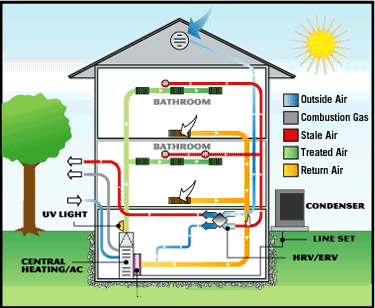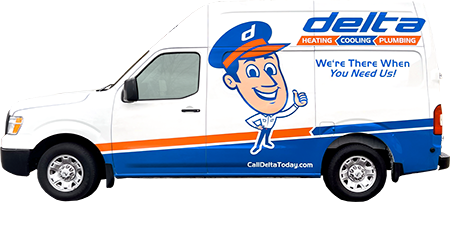Parts of an HVAC System

An HVAC System is what moderates the temperature within a building to keep the interior at a comfortable climate. What this basically means is that the HVAC system brings heat in the winter and cold air in the summer. If this still doesn’t make any sense, HVAC stands for “heating, ventilation, and air conditioning”. When HVAC system parts use their forces together and function correctly, it makes the HVAC system more efficient.
What a more efficient HVAC system does is it operates with less power when accomplishing the needed of cooling and heating functions. The more efficient an HVAC system operates results with the owner paying less money to operate in terms of gas and electric bills. The importance of keeping regular maintenance on your HVAC system is fairly important due to how much they can save an owner money for their business.
If repairs are necessary on an HVAC system, your local technician at Delta Heating, Cooling & Plumbing can help!
The Furnace
A furnace is oftentimes a large piece of equipment as it needs its own space for operation. They’re usually placed in closets, attics, or basements due to how large they are. What a furnace does is it pushes the air (whether cold or hot) into the ducts running throughout every room inside of the home or building. With the ducts performing this task, the cool or warm air can effortlessly pass throughout the rooms and change the temperature. The furnace is an important piece to the HVAC system, you also want to make sure that it doesn’t need to be repaired.
The Heat Exchanger
What the heat exchanger does is it resides inside of the housing of the furnace unit. Once the furnace is operated with the thermostat, the heat exchanger responds by matching the desired temperature. The air is then passed over the heat exchanger, which comes from a separate duct (where your filters are located) that pulls the cold air out of the room. The duct that performs this is called the cold air return chase. Once cool air comes over the heat exchanger, it’s then heated and blown through the building’s ducts. If the furnace happens to be operating on gas, the heating process is assisted by gas burners. If it happens to use electricity, the process is done through electric coils and possibly a evaporator coil.
The Inducer Draft Motor
The inducer draft motor is a small motor with a big job, often located on furnaces (gas fired) that have been made in the last fifteen years. What the inducer motor does is it helps pull any burned exhaust fumes from the heat exchanger so that the fumes can be exhausted outdoors. Commonly, inducer draft motors run whenever the heating system itself is operating. Since the inducer draft motor is in the line of heat (literally), it takes a beating. Replacements are often needed within ten to twelve years.
Gas Valve
What the gas valve does is it allows gas to pass thoughout your heating systems whenever a call for heat is needed from your thermostat. Such gas valves are modulating, 2-stage, and single stage. The power must pass through many different safety devices before the gas valve opens to ensure that it is safe for the gas to proceed. Gas valves are commonly closed and opened by solenoids, which are sensitive parts that can stop working and prevent gas from passing. It should be noted that gas valve replacements are fairly common with systems that have been around for less than ten years.
Blower Motor
A blower mower is a device that moves the air being blown throughout a home whenever it is being cooled or heated. Most of the work relies on the blower motor, as it delivers the correct amount of air so that the freezing or over heating of a system doesn’t negatively effect the task at hand. Heating can lead to the overheating of a mechanism; Cooling can lead to the freezing of a mechanism. Although there’s many different blowers on the market, the main ones consist of ECM Variable Speed, ECM, and PSC. The ECM (Electronically Commutated Motor) operates as a highly efficient blower running on DC technology.
The PSC (Permanent Split Capacitor) is the standard for an efficiency blower motor. However, the ECM Variable Speed blowers are highly recommended as a very high efficiency blower motor since they carry the ability to vary their speeds to deliver perfect amounts of air no matter the task. In addition to preventing damage during cooling or heating modes, the ECM Variable Speed motors will drastically lower humidity levels for cooler months since they remove humidity in the air. Unfortunately, if one of these motors happen to fail, expect to shell out a several hundred dollars. Regardless of the warranty the motors may carry, the labor for replacement is very expensive due to how much time is involved for repair. A great idea to keep a blower motor strong is to change the filters often. Doing so prevents the blower motor from working harder.
Control Board
The control board is the setup in which operates the entire system. It contains the resistors, modules, relays, etc. that control how the system is operated. Since furnaces leap forward in advancements, the boards become more complex. Some furnaces have mini processors that speak with one another for increased functionality and speed. Unfortunately, if a control board happens to fail, a replacement or repair can be pretty costly depending on the model, type, and advancements the board carries for your system to operate. In addition to this, the price also relies on the parts warranty.
Conclusion
Considering the information above, it’s fairly important to know how an HVAC works and the parts that need to be regularly maintained for maximum efficiency. In addition to keeping a home or building a comfortable temperature, a great HVAC system can save the owner a lot of money in the future. If you have any questions about your HVAC system, don’t hesitate to contact Delta Heating, Cooling & Plumbing.
